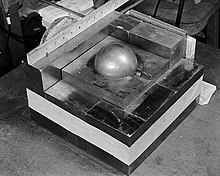This article contains several duplicated citations. The reason given is: DuplicateReferences detected: (October 2024) |

The demon core was a sphere of plutonium that was involved in two fatal radiation accidents when scientists tested it as a fissile core of an early atomic bomb. It was manufactured by the Manhattan Project, the U.S. nuclear weapon development effort during World War II. It was a subcritical mass that weighed 6.2 kilograms (14 lb) and was 8.9 centimeters (3.5 in) in diameter.
The core was prepared for shipment to the Pacific Theater as part of the third nuclear weapon to be dropped on Japan, but when Japan surrendered, the core was retained for testing and potential later use in the case of another conflict.
The two criticality accidents occurred at the Los Alamos Laboratory in New Mexico on August 21, 1945, and May 21, 1946. In both cases, an experiment was intended to demonstrate how close the core was to criticality with a tamper (layer of dense material surrounding the fissile material). Still, the core was accidentally put into a critical configuration. Physicists Harry Daghlian (in the first accident) and Louis Slotin (in the second accident) suffered acute radiation syndrome and died shortly afterward. At the same time, others present in the laboratory were also exposed. The core was melted down during the summer of 1946, and the material was recycled for use in other cores.